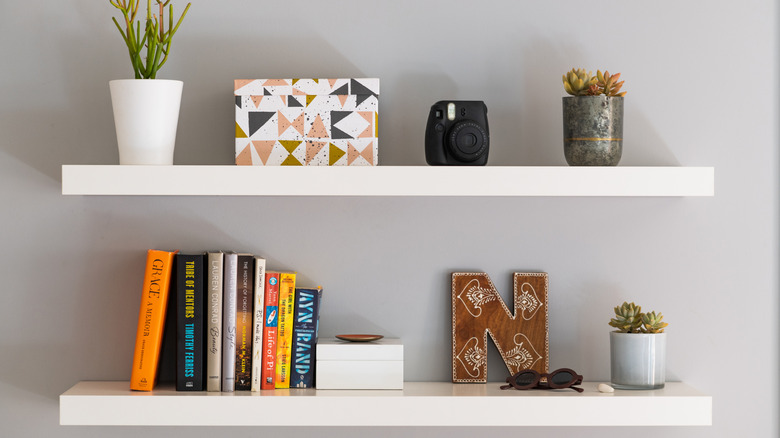The Easy Way To Drill Level Holes In Your Floating Shelves (Without A Drill Press)
Floating shelves are the quintessential minimalist way to display items in your home. Their sleek design fits with nearly any aesthetic, while the lack of visible hardware means they look seamless and do not make your room feel smaller in ways that bulkier shelves could. Whether you are trying to DIY a long floating shelf for your wall that looks like a pro custom build or just mount a small shelf on a bracket, it can be difficult to complete the job if you do not have the right tools. Drilling a straight hole in a narrow piece of wood without veering off course and popping out of the top or bottom may be a tough task. While a drill press makes the process easy, there are some clever ways to get a perfectly drilled hole in your shelf without one. One simple option is to create a jig that can help stabilize your drill as you bore the hole. The drill bit rests against the jig, ensuring that the hole is straight and parallel to the shelf's surface.
All you need for this hack is a drill with an appropriately sized bit, a level, a measuring tape or ruler, wood for the jig, your shelf piece, and a way to secure the jig to the shelf piece as you drill, such as a clamp or non-damaging, temporary spray adhesive. The piece of wood for the jig should be long enough to extend off the shelf piece when laid perpendicularly across it. When choosing your bit, it may help to learn the drill bit sizing hack that you have been missing your whole life.
How to make this floating shelf hack work for your projects
Measure and mark where the bracket hole needs to go on the floating shelf. Then, find the correct height to drill the hole in the shelf, and check the distance between the top of where the hole will be and the bottom of the jig piece when it is laid across the top of the shelf. Make sure you measure from the jig to the top of the anticipated hole and not the center of the shelf piece, or else your hole will be lower than anticipated. The holes can be slightly off-center as long as they are even, but make sure that the thicker side is at the top and not the bottom to better support the weight of the shelf. With that measurement, cut out a small wooden block, and adhere it to the bottom of the jig piece.
Next, temporarily secure the jig to the shelf, making sure it is perpendicular. Begin drilling while holding the shaft of the drill to the bottom of the small wooden block. This should help you keep your drill level vertically, but you can experiment with different shapes instead of a flat, square block to give yourself even more stabilization. Cutting a V-shaped notch or tube in the block, for instance, may make it easier to lock the bit's shaft in place by reducing the potential of moving from side to side. With your holes drilled perfectly straight, you just have to make sure you know how to determine the perfect height for your floating shelves, and they will be ready to install.
